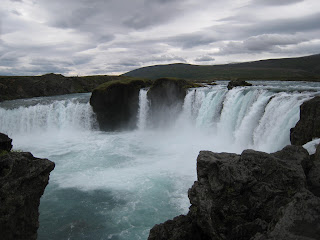I thought I would talk a bit about animals. The only known indigenous mammal in Iceland is the Arctic fox and no, we did not see any - my guide book reports that there are only about 5000 left in Iceland but also states they are a special creature that has adapted to the extreme conditions - one being fur on the bottom of its paws and the warmest coat of any mammal in the world - I definitely think they would need it as when the wind blows here - it is cold - even with the warm sun.
What Iceland does have in significant numbers is sheep and horses. About 750,000 sheep live in Iceland - more than twice the people population and while we did not see that number of sheep, we saw hundreds, if not thousands. They were often in small groups of 3 to 6 or so and scattered all over the place, high on the mountains, close the sea, right beside the road and sometimes right in the road. From time to time there was fences but it did not seem to matter as we often saw sheep on both sides of the fence. If you hit or kill a sheep you are responsible for paying for that sheep so we kept a beady eye on them. We are still not sure how we would find the farmer attached to a sheep as many sheep seemed a long, long way away from anywhere. Again, my guide book tells me that the farmers do a round up or rettir in September which takes about a week. The mount their horses and go riding off into the wilderness in search of their sheep. The sheep are then brought in to central sorting pens with the help of the Icelandic sheepdog or fiarhundur . Here are a few pictures of the Icelandic sheep - their coats come in all different colours - brown, black, cream/white, and combinations of those colours - it was very common to see a couple of cream sheep with a black lamb or a very shaggy brown one.


we came upon this one on a short hike - she really stared at us and
seemed to say - 'hey no way are you getting this bench!'
The icelandic sweater is very popular and worn not only by the tourist, we saw many locals including farmers in the field wearing the sweater. It is the traditional yoked sweater with the pattern around the neck and sometimes around the waist and wrists. Unfortunately, they are way too itchy for me.
The Icelandic horse is a specialized breed and bred expressly for the land and climate of Iceland. Many years ago, the Althing passed a law forbidding the future import of any foreign horses. Now, if an Icelandic horse leaves Iceland, it is never allowed back in - this is to keep the breed pure. One of the unique attributes of the Icelandic horse is that is has a fifth gait (most horses only have 4 - walk, trot, canter, gallop) Icelandic horses has a fifth - tolt with occurs between a trot and canter and is incredibly smooth. They too come in all different colours, dappled to all-white, brown with blonde hair, grey to reddish. We came upon a herd along the side of the road and were able to snap a few pictures, when we started the car to leave the horses ran along side of us - and when we stopped they stopped too - it was very cool.

































